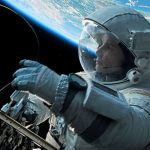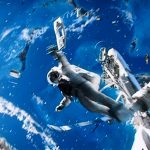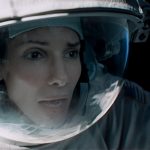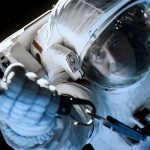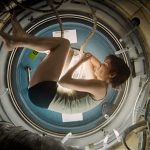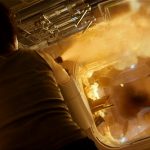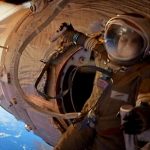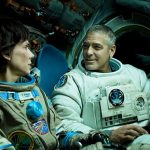Gravity – 2013
There are those who say that Gravity is one of the best science fiction films ever made and I might have to agree. Why? Because it is solidly rooted in today’s technology. Even real astronauts like Buzz Aldrin and Michael J. Massimino praised the film for its realistic depictions of the environment of outer space. The zero-g conditions were perfectly executed. Extreme attention was given to detail, and apparently nothing was overlooked. In fact Massimino was quoted as saying, “Nothing was out of place, nothing was missing. There was a one-of-a-kind wire-cutter we used on one of my spacewalks and sure enough they had that wire-cutter in the movie.”
The film’s lead actors, who happened to be the only actors in the film aside from voice-overs, had to perform their parts in weightless conditions. Sandra Bullock and George Clooney really had their work cut out for them. Bullock played Ryan Stone, a medical engineer and mission specialist aboard the NASA space shuttle Explorer on her first space mission. Her commanding officer, played by Clooney, is Matt Kowalski, a veteran astronaut on his final mission. They are tasked with performing maintenance on the Hubble Telescope. Unfortunately, fate had other plans. While the two are outside the shuttle in environmental suits, the Russians blow up one of their defunct satellites. A terrible series of events causes the debris to go hurtling through space on a trajectory directly at the astronauts.
The deadly chunks of twisted metal are moving fast enough to puncture not only their space suits, but the hull of the space shuttle. Everyone but Stone and Kowalski are killed. Stone gets thrown from the wreckage and goes hurtling off into space. This scene was particularly well-shot, and it was almost terrifying to watch. Wearing a Manned Maneuvering Unit, or MMU, Kowalski flies out to retrieve her.
Stone is dangerously low on oxygen, and Kowalski is low on fuel for his MMU. Add to that the fact that the speeding debris will be circling the planet and heading their way a second time in ninety minutes, and the tension naturally begins to build. Their only hope of surviving is to use the MMU to make their way to International Space Station, which also lies within the path of the deadly debris field.
The movie is, at its core, a thriller. The race against time and danger, the struggle to make it to the ISS, and the fight against simple fear really tested them physically, intellectually, and emotionally. Things kept going from bad to worse. At one point, in order to save Stone, Kowalski sacrifices his life and goes flying off into space, allowing her to make it into the abandoned ISS. But once she makes it on board, she must quickly get into a landing capsule, as the Space Station is on fire and the debris cloud is coming around for a second pass. More damage and more destruction. The capsule has lost its parachute and is not fit for returning to earth. Her only hope is to make her way to the Chinese space station, Tiangong, and using their undamaged capsule to return to the planet.
I have to say that I was really impressed with Bullock’s performance. She had to ride an emotional rollercoaster, and thread an obstacle course of physical difficulties in order to play the part of Ryan Stone. She needed to learn to move and perform in zero gravity. She needed to express extreme fear and determination which skirted the edges of madness in order to take the audience on her journey with her. And she really came through like a trooper. Clooney was alright, but his part was really overshadowed by Bullock, who was nominated for Best Actress at the Oscars, though she did not win.
The special effects were simply phenomenal. Everything looked so completely real. Visual Effect Supervisor, Tim Webber, said that eighty percent of the shots in the film were CGI, courtesy of VFX company, Framestore. It was all wonderfully done, especially the debris storms. The use of sound, or lack thereof, was also important because, as we all know, there is no sound in space. From what I read, the first trailer for the film had audible explosions and other sounds, but these were taken out for the final cut of the film. The only sounds the audience was allowed to hear were the musical film score and what real astronauts would be able to hear, like voices through their headsets. It is interesting to note that the voice of Mission Control was provided by famous actor Ed Harris.
As I mentioned, the film was noted for its accurate depictions of physics and physical properties, though there were a few slight exaggerations which only people who actually work in the field of space exploration would recognize. The most blatant of these offenses was the fact that the Hubble Telescope and the ISS are in different orbits, which would make the daring flight from one to the other an impossibility. Also, Kowalski would not have been using the MMU to playfully fly around outside the shuttle. The use of that equipment is strictly planned and regulated. OK, I can give them a little artistic license. With everything he got right, director Alfonso Cuaron earned the right.
